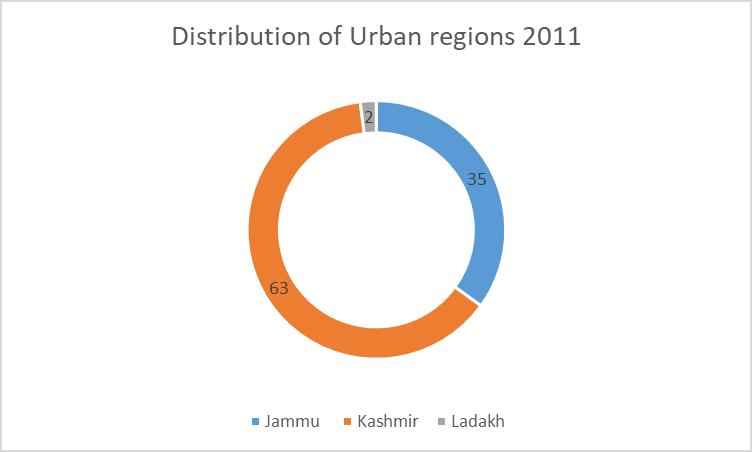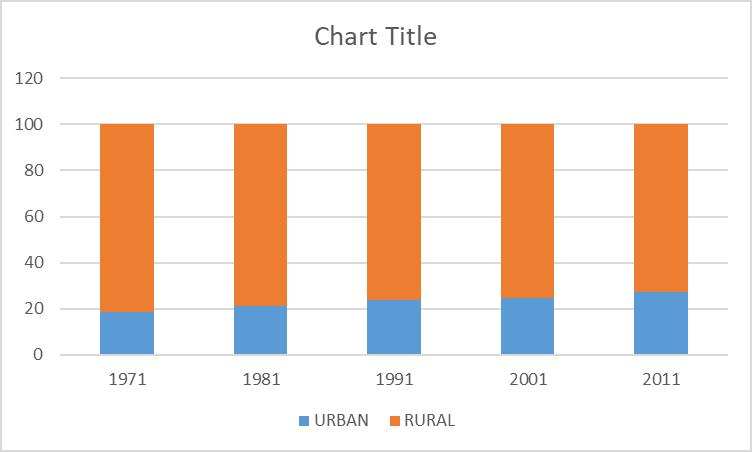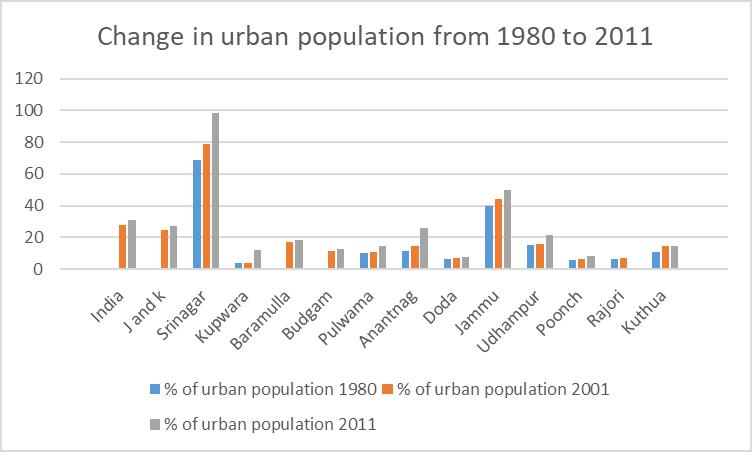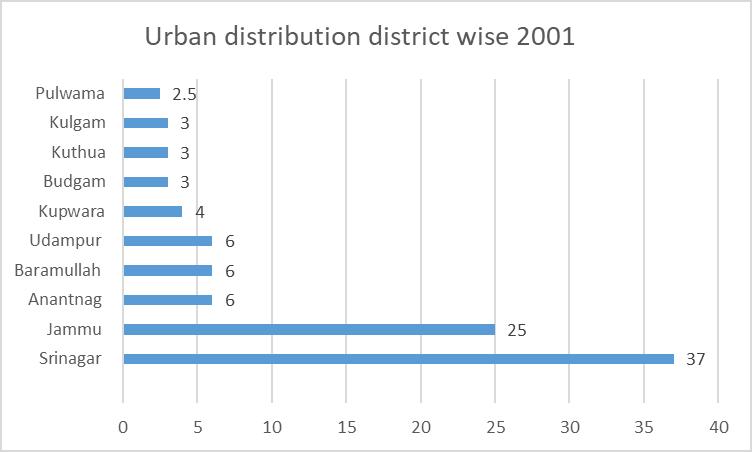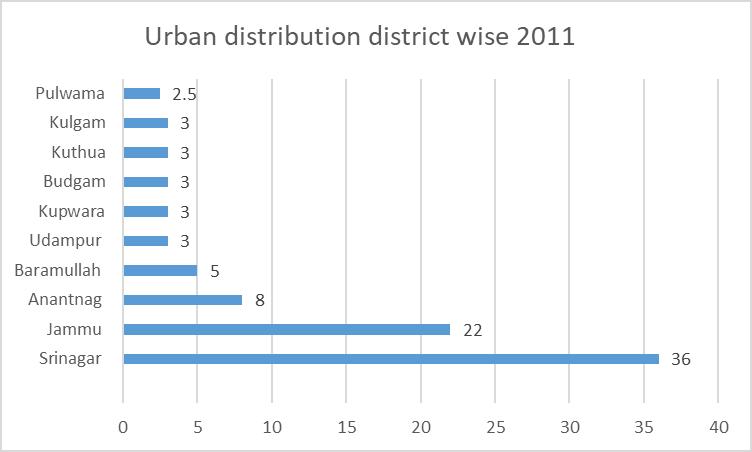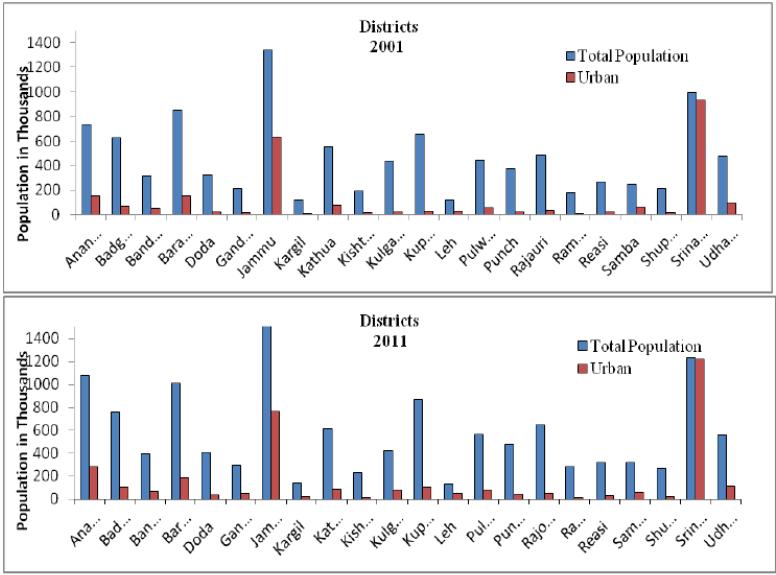TABLEOFCONTENTS
1. Synopsis 1-2
1.1ProblemStatement
12Aim
1.3Objectives
1.4Scope
1.5Limitation
1.6Methodology
2. Chapter1
2.1Introduction
22Ruralkashmir
3. Chapter2 6-16
3 1TrendsinUrbanizationofJammuandKashmir
3.2Districtlevelanalysis
3 3 Migration
4. Conclusion 17
Synopsis
1.1 ProblemStatement:
Srinagarwitnessedacceleratedgrowthinitspopulationinthelasttwodecades. The main factor which could be attributed to accelerated population growth during thesetwodecadeshavebeenmigrationfromruralareastourbanareas. The increase in the growth rate of population has also brought in its old excessiveconcentrationofeconomicactivitieswhichprovidedgreatimpetusfor the growth of subsidiary urban activities. Presently the overcrowding has led people to shift to theoutskirtsofSrinagarwhicharemostlyruralinnature.If these areas are left unattended it can lead to unplanned growth that can't be reversed Therefore, there is a need tobridgetherural-urbandivideandmake available the contemporary services and amenities in rural areas along with creatingjobopportunitiesandlivelihoodsfortheruralpopulationtoaddressthe issueofrural-urbanmigrationhenceleadingtosustainabledevelopment.
1.2 Aim: The aim of this study is to analyze the urbanization and migration patternsfromruraltourbanareasinJammuandKashmir.
1.3Objectives
Tounderstandthenotionofvillageincontemporarytimes
To analyze the trend and pattern of urbanization in Jammu & Kashmir 1981-2001
ToanalyzethetrendandpatternofmigrationinJammu&Kashmir1981-2001
1.4Scope:
Theresearchwillmajorlycollectdatafromcensus2011,2001and1981to understandthechangingdynamicsofurbanizationandmigrationpatternsin JammuandKashmironly
1.5Limitation: ThescopeoftheresearchislimitedtoJammuandKashmir onlywhichisthenorthernmoststateofIndia.
SeeratAmin (17ARC18)
From Village to the City: The Dynamics of Urbanization and Migration in J&K
1.6Methodology:
Differentmethodshavebeenusedtoanalyzethetrendandpatternof urbanizationandmigrationinjammuandkashmir.
FirstlythedatahasbeencollectedfromthecensusbookofIndia,2011,2001 and1981andarrangedaspertheneedtoshowthetrendandpattern.
secondlythepercentageofurbanpopulationhasbeenworkedoutbythegiven formula:
urbanpopulation%=(urbanpopulation/totalpopulation)x100
Toworkoutthechangeingrowthratebetweentwodecadesthepercentageof urbanpopulationofthecurrentdecadehasbeensubtractedwiththegiven previousdecadetoworkoutthechange.
Inmigration,thechangeinthepopulationhasbeenworkedoutbythegiven formula:-Growthrate=P(t)-P(o)/P(o)x100Where,
P(t)=populationofthecurrentyear
P(o)=Populationofthebaseyear.
Tofindoutthenetmigration,thegivenformulahasbeenused.
Netmigration=Inmigrants-Outmigrants.
Besidesthis,varioustables&graphshavebeenmadetoshowthepattern& trendofurbanization&migrationinthestudyarea.
Furthermore, adesktopsurveyhasbeenconductedtounderstandandmakea comparisonbetweenruralKashmirinthepastandincontemporarytimes.
SeeratAmin (17ARC18)
From Village to the City: The Dynamics of Urbanization and Migration in J&K
Chapter1
2.1Introduction:
Jammu & Kashmir, located in the extreme north of the country, is situated between32°17'and37°05'Nlatitudesand72°31'and80°20'Elongitudes Itis boundedonthenorthbyChina,ontheeastbyTibet,onthesouthbyHimachal PradeshandPunjabandonthewestbyPakistan.
Urbanization is one of the most important indicators of development The Process of urbanization in Kashmir valley dates back to the remote past The ancientcitywhichisknownasPandrethan(Puranadisthan)wasfoundedbyking Ashoka as his capital (272- 230 B.C). Since then a systematic record of the origin of towns has been established in the form of capitals. In the medieval period, a number of capital places originated but were confined within the compass of modern Srinagar and acted mainly as the socioeconomic and administrativecenters.Inthepresent period,aremarkableshiftfromruralareas tourbanareashastakenplace.OnthewholeSrinagarcityhasbeenthecapitalof Kashmirformorethan1300yearsinthepastwhichleadstoagreaterdegreeof urbanizationbywayoffunctioningasaprimatecity
Ruraltourbanmigrationisbecomingoneofthemostcommonmetaphorsofthe modernglobalizingprocessofpopulationmovementandalsoincreasinglyacts as a ‘transformation bridge’ between rural and urban areas Changes in the capital flows, investments, commodities, and information have created new avenues for people to find economic engagement outside their villages. The developmentofinformation,communicationandtransportationinfrastructureis becoming a determining element that facilitates and strengthens people’s movement,andalsoenhancestheirlinkwiththeruraloriginareas
SeeratAmin (17ARC18)
From Village to the City: The Dynamics of Urbanization and Migration in J&K
2.2Ruralkashmir
The Indian Census uses two factors to define urban and rural areas: administrativeprinciplesanddemographicandeconomiccriteria. As perfirst criteria, the state government grants municipal status- corporation, municipal council,notified area committee or Nagar Panchayats, etc.to asettlement. Thesetownsareknownasstatutorytownsormunicipaltowns.If,ontheother hand, a settlement does not meet the above administrative criteria but meets demographic and economic criteria, such as a population of 5000 people or more, a density of 400 people per square kilometer (1000 people per square mile), and at least 75%ofthemaleworkforceworkinginthenon-agricultural sector, Such areas aretermedasurbanandtheremainingareasaretermedas rural
Overthehundredyearsthisishow WalterLawrencedescribedruralarchitecture in his book The valley Of Kashmir HedescribestheKashmirivillagerichin naturalbeauties,shadedbythe treesofwalnut,appleandapricottreesandare wateredbyaclearsparklingstream .Hedescribesa cultivator'scottage,witha crumbling thatched gable roof, peeking out through the lush vegetation. He mentions Every residence has a vegetable-filled garden space, close to the cottage is a wooden granary, astructurethatresemblesalargesentryboxand from which grain is stored and extracted through a hole in the bottom. He describesthevillageasanampleroom.Thereisnocrowdingofhouses,andeach cottagestandswithinitsringfenceofearth,stonesorwattling Theearthwalls andthegardenplotsarebuiltverysimple andingeniousmanners Theearthis thrown into a mold that is formed by wooden planks, and on the top of the earthenslabsthornsarelaid,overwhichmoreearthisplaced.Hementionsthe housesaremadeofunburntbrickssetinwoodenframes,thehouseshavesloping roofstothrowoffsnow,thebalconyandtheloftarefestoonedwithropesofdry turnips, apples, maize-cobs for seed,vegetablemarrówandchillies,forwinter
SeeratAmin (17ARC18)
From Village to the City: The Dynamics of Urbanization and Migration in J&K
use.Therefore in his book he describes the life in kashmir villages revolves aroundagriculturalactivities only.
Butifwecomparethevillageinthepastandthevillageincontemporarytimes wefindoutthatthenotionofvillageinkashmirischanging Today'svillagein Kashmir is not just about agricultural activities. The village is in a transition mode.Thechangesarereflectedineverywalkoflife.Thesechangeshavebeen brought by various agents. These include science, technology, and spread of education, advent of media in rural areas, industrialisation, urbanization and migration Hencethelifestyle,attitudeandthinkinghavechangedgreatlyinrural Kashmir .Over the last century, rural-urban income parity hasimproved,farm populationhasdeclined,andruraleconomicdiversificationhasbeensignificant.
Rural areas, which have seen a lot of change, are a source of untapped opportunity Ruraldevelopmentisnotsimplyaboutthemeritsofprocessesand projectsthemselves;thepossibilityforsuccessprofoundlyweighsonawareness ofcontext.Ruralbusinessisunique;itmaynotjustbeaboutmakingmoneyfor thosethatseektomakealivinginruralspaces.Rurallifecaninvokeasenseof community,ofworkingtogether,andsocialchange.Theseeffortsexhibitholistic traits, such as sustaining local services, maintaining the local population, reducingnegativeclimateimpactsoflongcarjourneysthroughprovidinglocal servicesandemployment,andsustaininglocalcommunityevents,socialcapital andastrongsenseoflocalidentity.
It has been noted that rural places are undergoing transformation due to “globalization, economic downturn, public sector budgetary pressures, demographic aging, and climate and environmental change” Traditional rural jobs(mine,farming,andmanufacturing)nowaccountforonlyasmallportionof totalnon-metropolitanemployment.Themajorpopulationofruralemployment isinservice-typejobssimilartothosefoundincities(forexample,healthcare, construction,transportationretail,andsoon).
SeeratAmin (17ARC18)
From Village to the City: The Dynamics of Urbanization and Migration in J&K
Chapter2:Urbanizationandmigration patternsofJammuandkashmir
3.1TrendsinUrbanizationofjammuandkashmir
Table11:JammuandKashmir’stotalpopulationalongwithitsruralandurban populationfromtheyear1901–2011(inlakhs).
Source:CensusofIndia1971-2011
The 1991 census was not held in J&K. The population of India includes the projected population of J&K as on 1.3.1991 made by theStandingCommitteeof Expertsonpopulationprojections(Oct1989)
Table 1.1shows theoverall trendof populationin Jammuand Kashmiralong withitsrural andurbancomponentsfromtheyear1971-2011.Theruralpercent andtheurbanpercent arecalculatedaspertheaboveinformationonthebasisof itsruralandurbanpopulation ThetotalurbanpopulationofJammuandKashmir
SeeratAmin (17ARC18)
From Village to the City: The Dynamics of Urbanization and Migration in J&K
was8.58lakhs atthebeginningof1971,comprising18.56percentofthetotal population.
Withinaspanof50years,in2011thetotalurbanpopulationincreasedto2.51 millionconstituting2737percentofthetotalpopulation
Figure1 and figure2: Distribution of urban population in the three regions of JammuandKashmir.
SeeratAmin (17ARC18)
From Village to the City: The Dynamics of Urbanization and Migration in J&K
Figure 3: The overall trend of population in Jammu and Kashmir along with its ruralandurbancomponentsfromtheyear1971-2011
3.2Districtlevelanalysis
Table2TrendsofUrbanPopulationInJ&K1981-2001
SeeratAmin (17ARC18)
SeeratAmin (17ARC18)
From Village to the City: The Dynamics of Urbanization and Migration in J&K
Figure4:Growthrateinurbanpopulationfrom1980-2011
Figure 5 and 6 : Distribution of urban population in the districtsofJammuand Kashmirin2001and2011
Figure 7 and Figure 8: The urban population and the total population in 22 districtsofthestatein2001and2011(innumbers)
SeeratAmin (17ARC18)
From Village to the City: The Dynamics of Urbanization and Migration in J&K
SeeratAmin (17ARC18)
From Village to the City: The Dynamics of Urbanization and Migration in J&K
The analysis takes into account the censusof1981,2001and2011.However, The census in 1990 was not conducted in J&K because the situation was not goodthereduetopoliticalinstability TheurbanpopulationofJ&Kin1981was 21.09%,In2001itroseto24.81%andin2011itroseto27.38.Therewasa2.57 %growthinurbanpopulationofJammuandKashmir. ThecensusofIndia2011 showsthattheurbanpopulationinSrinagaris98.6%andinJammuitis50%. ThereisadrasticchangeintheurbanpopulationofSrinagarby1991%dueto variouspull factors HoweverJammuisalsoleadinginurbanpopulationafter srinagar.Since50%oftheJammupopulationis urbanizedasper2011censusof India . An interesting growth of urban populationcanbeseeninAnantnagas well . The growth rate of urbanpopulationis 11.84% asper2011censusof India Baramulla, Budgam, Anantnag, Pulwama, Udhampur, Kupwara and Kathua have181%,129%,262%,1435%,215%1203% and1455% respectively. The other districts have an urban population below 10 % as per census2011.Thisshowsthatthehighestpercentageoftheurbanpopulationlives inSrinagardistrict(98.91%)whichistheclearindicationofvariouspullfactors which attract people from everycornerofJammuandKashmirtosettlethere
While in less connected and border areas, the process of urbanization is very slowasmoreandmorepeoplemoveoutfromtheseduetolackofaccesstobasic amenitiesandfacilities..Thereisagreatvariationintheurbanpopulationacross thedistrictsofJammuandKashmir Thiskindof Variationisaclearindication of uneven urban development in Jammu and Kashmir If this kind of uneven development of urban areas continues then,thestatewillhavetofacevarious socio-economicandculturalrepercussionsingeneralandecologicaldegradation inparticular.
3.3 Migration
Oneofthemostessentialaspectsofpopulationchangeismigration.Thestudyof migration occupies an important place in population studies, because, in combination with fertility and mortality, it determines the size and therateof population growth, as well as, its structure and characteristics. Migrationis also essential in determining the distribution ofacountry'spopulationandthe growth of the working population in any given area. The measurement and analysisofmigrationareusefulinpreparingregionalpopulationprojections The study of migration is beneficial not only to demographers, but also to economists, sociologists, human geographers, political scientists, legal departments,policymakers,andplanners.Inmostcountries,ithasbeenobserved that industrialization and economic development have been accompanied by large-scale movements of people from farm areas to towns, from towns to anothertown,andfromonecountrytoanother Forexample,countriesinAsia, Africa, and Latin America, which are at present undergoing technological changes,areexperiencingsometypeofmigrationfromruraltourbanareas,and thesestreamsofmigrationhavegivenrisetometropolitancities.Thestreamsof migrationarefoundatnational,regionalandlocallevelbutwithdifferentkinds ofvariations.
SeeratAmin (17ARC18)
From Village to the City: The Dynamics of Urbanization and Migration in J&K
SeeratAmin (17ARC18)
From Village to the City: The Dynamics of Urbanization and Migration in J&K
Table:-3 StreamsofMigrationinJammuandKashmir1981-2001Internal migration
4.Conclusion
The current status of rural development is notentirelyfocusedonagriculture; much attention has been placed on the increasingly interconnectedconnection thatexistsbetweenruralandurbanareas Thelinkbetweennaturalamenitiesand rural development is still a significant opportunity that exists outside of agriculture and traditional land-use patterns. Rural towns have become more inventiveintheirapproachtodevelopment,makingbetteruseoftheirdistinctive senseofplaceandcreatinglivelyblendsoftheoldinhistoriclocations
Thestudyshows J&Kdisplaysalowerlevelofurbanizationwhichis2737%as comparedtothenationallevelof31.16%.HoweverthecapitalscitiesofJammu andKashmiri.e Srinagarand Jammu revealsignificantlevelsofurbanization. The study reflects the region wise and inter-districtdistribution ofurban population The level of urbanization in the state was2737% in2011 comparedto2481%in2001and2109%in1980 SrinagarandJammuarethe main centers of urbanization however Anantnagshowsapositiveurbanization pattern with 14.36 % population in2011and26.2%in2011withagrowthof 11.84%.
The analysis of migration streams in Jammu and Kashmirrevealsinteresting results.TheinternalmigrationfromRuraltoRuralatstatelevelshowsachange of897percentoccurredfrom1981-2001,Wherethechangeishigherinfemales than males Males in the Rural-Rural stream have changed by 5995 percent, whichisalarming.Thelargemalepopulationisshiftingfromruraltourbanareas insearchofbetterlifeandemploymentpossibilities,asshownbytherural-urban stream.TheUrban-Ruralstream,ontheotherhand,isexhibitingnegativetrends inpopulationchangeandmalemigration Femalemigrationfromurbantorural areas,ontheotherhand,hasincreased.Themigrationoffemalesatthetimeof marriageismostlyresponsibleforthisfavorabletrend.Theurban-urbanstream, ontheotherhand,indicatesapositivechange,whichisgreaterinfemalesthanin malesinthecaseofurban-urbanmigration isdominatedbymaleslookingfora betterwaytomakealivingandfindwork
SeeratAmin (17ARC18)
From Village to the City: The Dynamics of Urbanization and Migration in J&K
There are several features of rural communities that need to be developed Education, job opportunities, agriculturalandfarmingpractices,administration and management, infrastructure, civic amenities, health care, and medical and environmental conditions are few of them. When changes are made in these areas,ruralresidentswillbeabletoacquirebetteremploymentpossibilitiesand the decentralization of the capital cities will reduce to a larger amount
Furthermore, when the government, organizations, and otheragenciesdevelop approachesandstrategies,itiscriticaltoraiseawarenessamongruralresidents and assist them in reaping the benefits ofthesemeasuresandapproachesina timely manner The interaction of physical, technological, economic, socio-cultural, and institutional variables is the ultimate outcome of the developmentofruralcommunities.Approachesandtechniquesmustbecreated
SeeratAmin (17ARC18)
From Village to the City: The Dynamics of Urbanization and Migration in J&K
to improve people's lives, particularly those in poor and socioeconomically backward areas of society. It is vital to represent a crossroads of agricultural, social,managerial,behavioral,andengineeringdisciplinesinordertoencourage thedevelopmentofruralcommunities
SeeratAmin (17ARC18)
From Village to the City: The Dynamics of Urbanization and Migration in J&K
References
1. GovernmentofIndia.https://censusindia.gov.in, https://censusindia.gov.in/.Accessed15FEB2022.
2. GovernmentofIndia.CensusbookofIndia.1981.
3. GovernmentofIndia.CensusbookofIndia2001.
4. GovernmentOfIndia.CensusbookofIndia.2011.
5. GovernmentofIndia.“ReportoftheNationalCommissionon Urbanization.”Accessed01March2022.
6. Lawrence,WalterR. TheValleyOfKashmir.OxfordUniversityPress, 1895 Accessed07April2022
7 Talie,GulzarAhmad “TrendsandPatternsofUrbanizationandMigration inJammuandKashmir1981-2001.”InternationalResearchJournalof CommerceArtsandScience,vol.3,no.3,,www.academia.edu.Accessed 22Feb2022
SeeratAmin (17ARC18)
From Village to the City: The Dynamics of Urbanization and Migration in J&K



